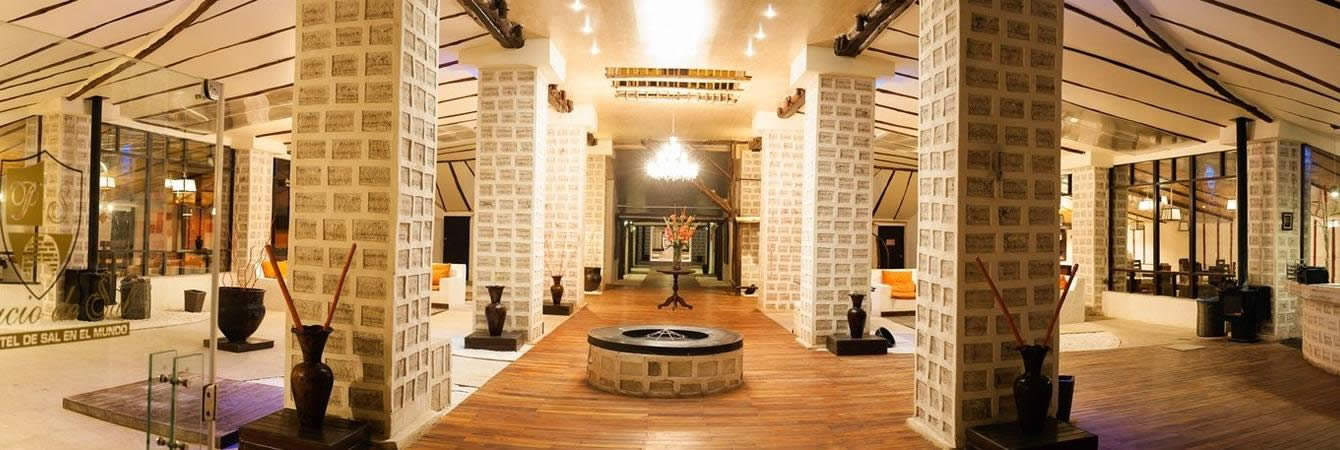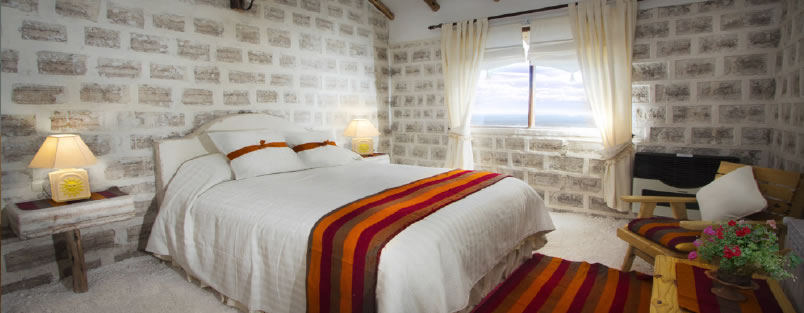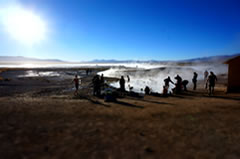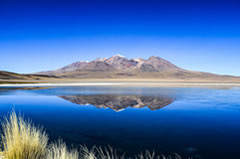Explore this itinerary:
Day One
San Pedro de Atacama - Border crossing at Hito Cajones - Green Lagoon - Licancabur Volcano - Salvador Dalí Desert - Polques thermal water - Sol de Mañana geysers - Colorada (Red) Lagoon - Stone Tree / Distance travelled: approximately 260kms
Your journey will start in San Pedro de Atacama. We will pick you up from your hotel to transport you to Hito Cajones border.
Once the immigration process is complete, you will board a 4x4 vehicle that will transport you to Bolivian territory.
During the trip you will appreciate landscapes truly out of this world.
We will visit the Eduardo Avaroa National Reserve which is home to wonderful Andean fauna. Pink flamingos, vizcachas, Andean foxes, llamas, alpacas, vicuñas: all living in their natural habitat.
The first stop of your tour will be the Laguna Verde (Green Lagoon), a wonderful turquoise coloured lake that reflects the imposing Licancabur volcano.
After a short visit to Laguna Verde we will enter the Dalí Desert, named this way because it is similar to some landscapes painted by the Spanish painter Salvador Dalí, although he never knew of the existence of this enigmatic place.
We will take a break to enjoy a delicious lunch followed by a relaxing bath in the Hot Springs of Polques.
The most prominent tourist attraction during our expedition in the Eduardo Avaroa National Reserve of Andean Fauna is the Laguna Colorada, breeding place of the pink Andean flamingo. If you are lucky, you can see thousands of them feeding in the red waters of the lake. The peculiar red color of the lagoon is due to sediments and pigments of the algae living in the lake. The shades of water vary from brown to intense red.
We will conclude our day by visiting the Stone Tree, a rock formation similar to a tree forged by the erosion of the wind.
Lodging at the Tayka Desert Hotel. This unique and very remote hotel is located in an inhospitable location just outside the Eduardo Avaroa National Reserve. The Hotel has comfortable rooms with private bathroom, hot water and heating until 21:30 hrs.
Dinner will be served at the hotel restaurant.
Day Two
Hedionda Lagoon - Cañapa Lagoon - Ollague viewpoint - Uyuni Salt Flat / Distance travelled: approximately 250kms
After breakfast and with fresh energy you will continue your journey in the Uyuni region.
We will travel on dirt trails until we reach the Laguna Hedionda (Stinky Lagoon, a name earned by the sulphuric gases emanating from the waters), home of hundreds of pink flamingos. Then we will cross a difficult rocky area until we arrive at the Laguna Cañapa.
This lagoon is considered unique due to the large amount of Andean fauna that it shelters.
We will take advantage of the beautiful landscape to enjoy a delicious lunch.
Then we will continue the adventure by heading towards a privileged viewpoint to observe the active Ollague volcano towering at a height of 5868 meters above sea level.
The Ollague Volcano has a crater of 1250 meters in diameter, partially eroded on the southern section leaving traces of lava. Also, from the air, two fumaroles can be recognized: the main, which measures about 100 meters and the second located at the top of the volcano.
You will travel a few kilometers to the North, from where the Majestic Salar de Uyuni will welcome you.
We will cross this white desert until to arrive at the village of Colchani where the Salt Palace (Palacio de Sal) Hotel is located. This was one of the first salt hotels built in the region.
Hotel Palacio de Sal has comfortable rooms equipped with private bathroom, hot water, heating and Wi-Fi.
You will have dinner at the hotel restaurant.
Day Three
Uyuni Salt Flat - Eyes of the Salt Flat -Incahuasi Island - Sunset - Train cemetery - Uyuni town / Distance travelled: approximately 185kms
The day you have been waiting for. After breakfast you will begin your excursion to the wonderful Salar de Uyuni.
We recommend the use of sunscreen, dark glasses, comfortable shoes, slippers (in case there is water in the salt flat) and a cap.
We will make the first stop at the "eyes of the Salar": small holes that reveal the water flowing below the Salar de Uyuni. These waters have rich healing properties due to the minerals they contain.
Next we will travel to the Hotel Playa Blanca, an old salt hotel closed due to the environmental impact it had on the Salar. You can take some great photos and enjoy the scenery.
We will travel through this huge white desert and reach Incahuasi Island: an "island" located in the middle of the white salt desert that shelters a large number of giant cacti, some over a thousand years old.
We will enjoy a delicious lunch.
After lunch you make a light trek towards the first viewpoint of the Incahuasi Island. On the way you will be surrounded by the hundreds of cacti that inhabit the place.
After contemplating the view of the salar from the hilltop of Isla Incahuasi, we will travel to a great place to take photographs; these fun pictures will be the envy of all your friends back home!
You will watch a beautiful sunset in the Salar de Uyuni. A true spectacle of nature, this will be one of the best highlights of your trip!
We will visit the Train Cemetery located on the outskirts of the salt flats. This tourist destination concludes our journey through beautiful landscapes of the South West region of Potosí.
We will conclude the expedition in the city of Uyuni at approximately 19:30 hrs.
Accomodation
First night: Tayka Desert Hotel - Hotel del Desierto Tayka

The Hotel Tayka del Desierto (Ojo de Perdiz) may be the most remote hotel in existence. Located 220 km from Uyuni and 200 km from San Pedro de Atacama in Chile , there is literally nothing anywhere within many miles of this place. You are almost on the Chilean border. The hotel exists solely to support the tours of Bolivia's remote and rugged desert southwest, and the supplies are all shipped in from Uyuni.
The hotel was built by four local families and is very much in tune with its environment, the impressive Siloli desert expanse with its untouched towering mountains in the background. The hotel offers friendly service and local food.
Second night:
Stay in one of these unique salt hotels:
Hotel Palacio de Sal
The Palacio de Sal Hotel & Spa was recently remodeled, and is built entirely of salt: walls, floors, ceilings, and much of its furniture and decoration: chairs, tables, beds and sculptures are made of salt, so it is considered unique in the world.
Luna Salada Hotel
Designed to entertain visitors on adventure or pleasure trips, the Luna Salada Hotel is one of the most extraordinary hotels in the world. Located in the Salt Flats of Uyuni, the Hotel and its furniture has been constructed from blocks of salt and there is granular salt sprinkled on the floor.
Make your tour truly special with these extra activities:
Stargazing
Barbecue inside the Salar de Uyuni
What to bring
- Comfortable and warm clothing.
- Comfortable footwear (ideally for trekking).
- Swimsuit and towel (to bathe in the thermal waters of Polques).
- Sunglasses.
- Sunscreen.
- Cap or hat
- Additional beverages and water
- Pills to alleviate altitude sickness
Gallery
Check out these awesome trip photos:
Tour FAQ
What travel documents do I need to enter Bolivia?
- Valid Passport
- Visa if applicable. Check the list of countries that need visa to enter Bolivia
What's the baggage allowance?
We can transport 1 baggage per person - 20 kg
What level of Wi-Fi access should I expect?
You will have WiFi internet access at Hotel Palacio de Sal
There is no Wi-Fi inside Eduardo Avaroa National Park
What days of the week does the tour leave?
The tour can leave on the day of your convenience. Reservations need to be made in advance.
How far in advance should I book the tour?
Due to the high demand in the hotels included in the tour itinerary, we recommend booking at least one month in advance
Do I need to be vaccinated against yellow fever for the tour?
The yellow fever vaccine is not required for the Salar de Uyuni tour. It is only required if you will later visit the Bolivian jungle (e.g. Rurrenabaque or the Chiquitania).
What vehicles does the tour use?
The tour includes a minibus in Chilean territory to the border and a 4x4 vehicle in Bolivian territory to Uyuni.
What is the weather like during the tour?
In summer (December to March), the temperature varies from approximately 4 ° C to the lowest, up to 23 ° C as the maximum. In winter (June to September), the temperature varies from approximately -20 ° C to the lowest, up to 16 ° C as the maximum. Radiation from the sun is always high due to the altitude, so the use of sunscreen is highly recommended.
How much money should I bring for the tour?
We recommend to take at least 100 Bolivianos per person for the border tax (30 Bolivianos per person), access to bathrooms at the rest stops and purchase of souvenirs.
How likely is one to suffer altitude sickness during the tour?
Most of the tour itinerary is over 4000 meters above sea level, so one is quite likely to suffer from mild altitude sickness, especially during the first day of the tour. The 4x4 vehicle in which you will travel is equipped with an oxygen bottle. In any case, we recommend taking medicines that help you alleviate the altitude sickness.
What about the tour in case of rain or snow?
In case of rain, snow, or other extreme weather events, the tour route is subject to change, as some roads may be closed. In addition to the above, the Salar de Uyuni may be covered by water and access to Incahuasi Island (located in the middle of the salar) may be closed. In this case, you will not visit Incahuasi Island and you will enter the salar only to a distance that does not represent a danger to the passengers.
When is it possible to see the mirror effect in the Salar de Uyuni?
The mirror effect occurs when there is water accumulated on the salt flat. This occurs only during periods of rain (January and February) and after (March).








